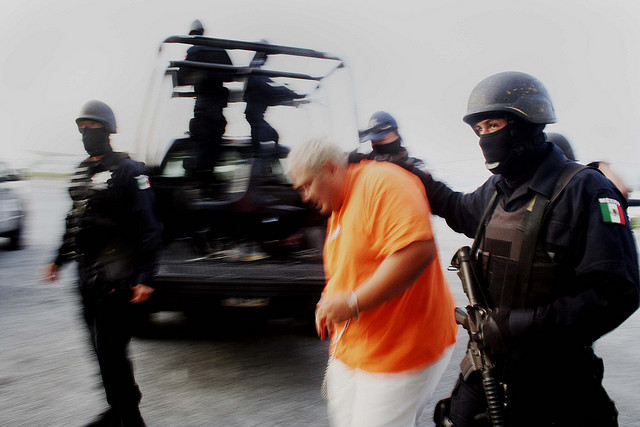Mexican soldiers make an arrest as part of a 2009 drug raid in the state of Michoacán. (Jesús Villaseca Pérez / Flickr)
Like the Islamic State, the Mexican drug cartels’ power has increased as the result of disastrous U.S. policies.
By Rebecca Gordon TomDispatch.com (3/22/15)They behead people by the hundreds. They heap headless, handless bodies along roadsides as warnings to those who would resist their power. They havepenetrated the local, state, and national governments and control entire sections of the country. They provide employment and services to an impoverished public, which distrusts their actual government with its bitter record of corruption,repression, and torture. They seduce young people from several countries, including the United States, into their murderous activities.
Is this a description of the heinous practices of the Islamic State (IS) in Iraq and Syria? It could be, but as a matter of fact it’s not. These particular thugs exist a lot closer to home. They are part of the multi-billion-dollar industry known as the drug cartels of Mexico. Like the Islamic State, the cartels’ power has increased as the result of disastrous policies born in the U.S.A.
There are other parallels between IS and groups like Mexico’s Zetas and its Sinaloa cartel. Just as the U.S. wars in Afghanistan, Iraq, and Libya fertilized the field for IS, another U.S. war, the so-called War on Drugs, opened new horizons for the drug cartels. Just as Washington has worked hand-in-hand with and also behind the backs of corrupt rulers in Central Asia, the Middle East, and North Africa, so it has done with the Mexican government. Both kinds of war have resulted in blowback — violent consequences felt in our own cities, whether at the finish line of the Boston Marathon or in communities of color across the country.
In Mexico, the U.S. military is directly involved in the War on Drugs. In this country, that “war” has provided the pretext for the militarization of local police forces and increased routine surveillance of ordinary people going about their ordinary lives.
And just as both the national security state and the right wing have used the specter of IS to create an atmosphere of panic and hysteria in this country, so both haveused the drug cartels’ grotesque theater of violence to justify their demonization of immigrants from Latin America and the massive militarization of America’s borderlands.
The War in Mexico
If there was an official beginning to Mexico’s war on drugs, it would have to be considered the election of Felipe Calderón as the country’s president in 2006. The candidate of the right-wing Partido Acción Nacional, the National Action Party (PAN), Calderón was only the second Mexican president in 70 years who did not come from the Partido Revolucionario Institucional, the Institutional Revolutionary Party (PRI). His predecessor, Vicente Fox, had been the first.
It was Calderón who, with encouragement and assistance from the United States, changed Mexico’s war on drugs from a metaphor into the real thing, in which guns and grenades would fuel the deaths of more than 60,000 Mexicans through 2012.
The current president, Enrique Peña Nieto of the PRI, admits that another 27,000Mexicans were murdered in the first year of his presidency. At least another25,000 have been disappeared since 2007. It was Calderón who brought the Mexican military fully into the fight against drugs, transforming an ineffective policing policy into a full-scale shooting war with the cartels. At least 50,000 military personnel have been deployed.
In addition to ordinary citizens, journalists and politicians have been particular targets in this war. The Committee to Protect Journalists reports that murders of Mexican reporters have increased dramatically since 2006. Among those whose killers have been positively identified, 69% died at the hands of the drug cartels, and at least 22% were killed by government or military personnel.
Wikipedia lists over 100 politicians who have lost their lives in Mexico’s war on drugs. That list does not include a woman named Aide Nava González, whose headless body was dumped this month on a road in Guerrero state. Nava was contending for the Partido Revolución Democrática, the Democratic Revolution Party, slot on the ballot in the town of Ahuacuotzingo. Her husband, the former mayor, had been murdered there last year. A note from Los Rojos, a local drug gang, was left with Nava’s body. “This is what will happen,” it read, “to anyone who does not fall in line, fucking turncoats.”
Guerrero is the home of Ayotzinapa, a town where 43 teachers-in-training once attended a rural teachers college. All 43 “disappeared” last September during a demonstration in the neighboring town of Iguala. Their arrest by police, and apparent subsequent murder at the hands of a local drug gang, Guerreros Unidos, was one of the few stories of Mexican suffering to break intothe U.S. mainstream media last year. The mayor of Iguala has since admitted that he instructed the police to hand the students over to the gang and has been arrested, along with his wife. The town’s police chief is still on the run.
Like the “war on terror” globally, Mexico’s war on drugs has created endless new pretexts for government repression, which has its own lengthy history in that country. That history includes the long-remembered police murders of some 300 students, among the thousands protesting in Mexico City’s Plaza de las Tres Culturas a couple of weeks before the Summer Olympics began in 1968. Juan Méndez, the U.N.’s Special Rapporteur on Torture, wrote in his 2014 mission report on Mexico:
“The National Human Rights Commission recorded an increase in the number of complaints of torture and ill-treatment since 2007 and reported a peak of 2,020 complaints in 2011 and 2,113 in 2012, compared with an annual average of 320 in the six years prior to 2007. Between December 2012 and July 2014, the Commission received 1,148 complaints of violations attributable to the armed forces alone.”
According to Méndez, it’s difficult to pinpoint the exact number of torture cases in the country in any year, because there is no national registry that records such complaints. Nor is everyone who was tortured by representatives of the government likely to report their suffering to that same government.
What is not difficult to pinpoint is the nature of the torture. Méndez notes the “disturbing similarities” in the complaints of those tortured. The police and the military are regularly reported to use a combination of “punches, kicks, and beatings with sticks; electric shocks through the application of electrical devices such as cattle prods to their bodies, usually their genitals; asphyxiation with plastic bags; waterboarding; forced nudity; suspension by their limbs; [and] threats and insults.”
The purpose of such torture is clear as well. As Mendez reports, it’s “to punish and to extract confessions or incriminating information.” A 2008 change to the Mexican constitution makes it easier to do this: under this policy of pre-trial detention (arraigo in Spanish), suspected drug traffickers can be held for up to 80 days without charge. According to the Mexican Commission for the Defense and Promotion of Human Rights, “Supposedly, arraigo is used as a means to investigate suspected criminals, but in practice, it is used as a kind of public scrutiny that allows more time for the authorities to determine whether the detained is guilty or innocent.” It’s much easier to extract a confession when you have electric cattle prods and waterboarding at your disposal.
Washington Fights a “War” in Mexico
Who pays for Mexico’s war on drugs? You won’t perhaps be too surprised to learn that the United States foots a major part of the bill. Between 2008 and 2014,Congress has appropriated $2.4 billion dollars to fight the cartels, as part of theMérida Initiative, a “security cooperation agreement” between the U.S. and Mexican governments. That money supports a failed war in which tens of thousands have been killed and thousands more tortured.
U.S. involvement, however, goes far beyond money…




